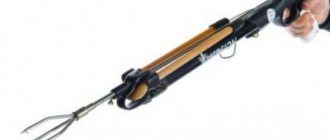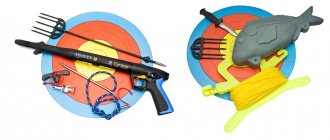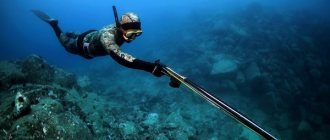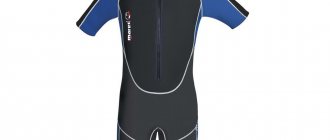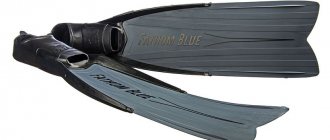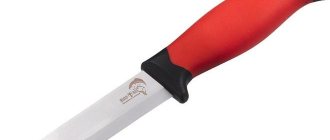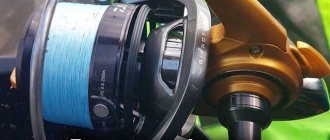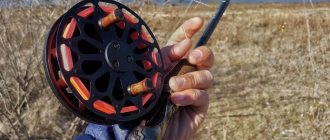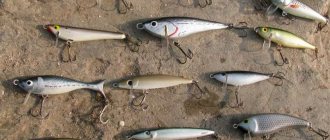A flashlight is a very useful thing in all areas of human life. This is an excellent working tool, and for various types of outdoor activities it is also an indispensable assistant. Diving is no exception, because everyone knows that there is never enough light under water, both at night and during the day. But novice divers make one, sometimes fatal mistake, which is the belief that one diving light is quite suitable for everything and that a second one is not needed. But this is often not the case, and life often gives them a chance to verify this.
Criteria
But first you need to understand what criteria you need to use to choose a flashlight. We have prepared a list that will give valuable advice to a beginner:
- One of the most important criteria is the ability to keep water out. Therefore, you should pay attention to the markings of the flashlights and look for the IPX8 mark - the maximum level of water resistance. The test of such flashlights is usually carried out at a depth of up to 30 meters.
- One of the biggest troubles that can happen to a flashlight is its sudden failure. Therefore, choose a flashlight with a maximum operating time, which for xenon lamps is 25 thousand hours, and LED lamps last 50 thousand hours.
- To prevent it from falling apart from an accidental blow, make sure that the purchase is made of very high-quality materials.
- Ask the seller about the power and range of the device's light that will be needed for your diving conditions. These are very important parameters, do not forget about it.
- Operating life on one charge.
Flashlights for spearfishing and swimming are divided into 2 types: those that operate on batteries and those that operate on batteries.
- Battery-powered ones are convenient because, without requiring recharging, they can work continuously for 3 hours in a row, but their power is very low and has a limit of 5 W. They are optimal for use in spare flashlights for spearfishing and diving.
- Rechargeable ones do not complain about a lack of power, having a reserve of 15–100 W, good compactness, excellent color rendition, and often work much longer. There are two downsides: the size and the fact that the batteries need to be charged periodically. You also need to put the diving light that uses them on safety.
Nowadays, the most optimal is the use of rechargeable batteries, which should ensure that the flashlight glows for at least 2 hours of continuous operation. Other modes should last at least 3–4 hours on a single charge.
- A very useful feature would be the presence of replaceable reflectors. For example, if you decide to swim up to a school of fish, the light from your flashlight may scare them away. In this case, you simply put on a red rubber diffuser, which most fish do not react to, and calmly swim among them.
- Be sure to check the strength of the fastening and the cord. Otherwise, you risk losing it during a dive.
Choice
How to choose the right device? To do this, you need to look at several important parameters. This way you can quickly find a quality product:
- The main characteristic that you need to pay attention to first of all is the waterproof case. It does not allow water to penetrate inside, so everything remains intact. Before purchasing, you need to look at the indicator of moisture and dust protection. The maximum level is IP68. Then you can dive under water to a depth of 30-60 meters.
- You also need to look at the operating time. It often happens that due to frequent use, the flashlight suddenly turns off, leaving a person in the dark. It is better to choose LED options that last over 50 thousand hours.
- You should look at the shock resistance of the diving flashlight body. It must be borne in mind that the lower the price, the worse the external part. The device breaks or cannot withstand underwater pressure.
- It is important to find out the power and range of the glow. The product is selected depending on the diving conditions.
- Battery life matters.
- It is important to have replaceable reflectors. This is a necessary requirement for students studying underwater space. To avoid spooking the fish, a red diffuser is required. A person will see everything, but this will not frighten the inhabitants of the underwater world.
- Be sure to check the reliability of the fastening. If you ignore this point, there is a possibility of losing the flashlight.
These are the main selection criteria that are important to pay attention to. These aspects will help you find the right device. Mistakes in choosing can ruin your entire underwater trip. So it is important to rely on these recommendations to help you choose a quality device.
Kinds
What types of flashlights are there? The following types of products can be found in stores:
- The first option operates on standard batteries.
- The second one works using rechargeable batteries.
The advantage of battery-powered flashlights is that they do not require recharging. They are very easy to replace. Continuous operation lasts 3 hours, which is enough for a short dive under water. The downside is the power, which is usually no more than 5 W. Therefore, experts use such models only as a backup option.
Rechargeable flashlights have good power, which can be 15-100 W. This compact equipment has high-quality color rendering. It is important to consider that battery-powered devices last several times longer. But they need constant charging.
Nowadays, battery options are especially in demand, as they provide continuous operation for several hours. There are also economical modes that do not consume energy, which helps to keep the light on longer.
Design Features
When choosing a device, you need to study the description and characteristics. Design is another important nuance. In stores you can find 2 types of underwater flashlights:
- With one body.
- With two.
The standard model has 1 body where all the elements are located. The design of such a device is simple. This flashlight is not suitable for all purposes, as it has a low stability rating.
Two housings can be selected for professional use. The first contains the batteries, and the second contains the optical parts and the power button. The connection is made with a special cable.
The advantage of 2-case devices is that they have high power, but this affects the size. Therefore, such models are not compact. Most of the space is reserved for batteries.
The mounting option for this option is simple. The first part with power is located on the diver’s equipment, and the second, where the flashlight is located, is fixed in the hand. There is also a head-mounted version, which is much more comfortable for scuba diving.
Design
Special attention should be paid to the design of flashlights for spearfishing and diving. There are two main types: those that use one body, and those that have as many as two.
The first type encloses all elements in one body. This is a reflector, a switch, a battery and a light bulb. Nothing complicated.
But the design of the second type is more complex and interesting. The first housing of such flashlights contains power, while the second includes optics and switches. They are connected using an electrical cable and have a design of replaceable blocks for all elements. It is also interesting that double-body flashlights have greater power, which entails considerable size (mainly due to the large batteries). The housing with power supply is attached to the diver’s equipment, and the diving flashlight itself is in his hands. Sometimes a light bulb with a reflector is designed like a headlamp.
The convenience of the mounts plays a big role for those divers who are interested in underwater photography, spearfishing, swimming in caves and sunken ships - after all, free hands are very necessary in such dives. Therefore, flashlights are often attached to equipment using clothespins or special handles if the flashlights are large. Some underwater cameras have special mounts for light sources.
One of the most successful and convenient designs is a headlamp for diving. They are worn using straps or attached to the diver's helmet.
Low-power flashlights are mainly made in plastic cases, but more serious models come in metal, often aluminum. Sealing is ensured by rubber plugs, which should be constantly checked before each dive. Otherwise, water may get inside, which will end badly for the flashlight.
But in order to choose a truly useful diving light, you need to have a clear idea of what type of scuba diving you will be doing and where you are going to dive. For example, if you dream of underwater photography, choose a powerful diving flashlight, preferably a halogen one. Such lights are mounted on video camera bodies. The same scuba divers who dive at night explore the compartments of sunken ships, purchase small flashlights with a flashing light and use them as a flashing beacon. Such a device is mounted on the buoyancy regulator.
Rating: choosing the Top 10 best flashlights for diving
| Name | Design | Power (lm) luminous flux | Immersion depth m. | Price, rub) |
| GRIPLITE STINGER | Manual | 260 | 150 | 2300 |
| Shallow Light 3W | Manual | 180 | 20 | 600 |
| NITECORE DL10 | Manual | 1000 | 30 | 5300 |
| Twist MX-02 | forehead | 300 | 30 | 500 |
| FA-XL-13T6 | Manual | 700 | 90 | 825 |
| Okdive OKDIVE09S | Manual | 1000–500 | 200 | 15000 |
| ULTRA FIRE HL-W34 | Manual | 1000 | 25 | 1000 |
| SCORPENA | Manual | 1000–30 | 40 | 4900 |
| LED Lenser D14 7456-M * | Manual | 85 | 60 | 5450 |
| FEREI HL51 | forehead | Up to 2800 | 50 | 17600 |
* – with a “theater spotlight effect” and perfectly centered optics. Allows you to collect up to 100% of the light flux. With a small luminous flux, a long range.
The table is given in order of increasing ratings from top to bottom.
The table shows that the simple design is for a novice diver engaged in “creative diving” or spearfishing (their diving depth does not exceed 20 meters). If the immersion depth must be higher and a powerful stream of light is required, then the price for such a light source is appropriate.
On AliExpress, prices for swimming lights start at $4.5. The number of positions is more than 4000. For personal use, you can choose any according to parameters and price. When choosing, it is recommended to read reviews and pay attention to the manufacturer.
Wholesale buyers who personally go to China to buy goods claim that they can buy any product of any quality there. Our wholesalers often buy the cheapest. That's why we say that the Chinese only make low-quality goods.
Important! In fact, they make all sorts of things, but they only bring bad ones to Russia. Their factory production is up to par.
Buying a lantern
Here you are at the threshold of the store, armed with basic knowledge about the designs and functions of flashlights for spearfishing and diving. But where to start buying.
The first thing you need to do is get a flashlight, which divers call a “pocket.” It is small in size, runs on batteries and fits easily into a BCD pocket. Such a purchase will not put a dent in your pocket, and you will use it for a very long time - since you will subsequently acquire a second, more powerful one, and this one will be an additional light source. The same wreck diving or diving into deep-sea caves requires participants to have at least 2 flashlights - the main one and a spare one.
You can immediately buy a large flashlight, so to speak, “for growth.” There are only two types of such flashlights for spearfishing and diving: the first one needs to be held by the handle on the body, which is not always convenient, and sometimes it’s just heavy due to the weight, and we have already written about the design of the second one - these are batteries on the equipment and a light flashlight , attached to the hand.
When choosing, you should pay attention to the latest models, in which light bulbs are replaced with LEDs, which are now capable of producing up to 3000 lumens. The spectral composition of such lamps ranges from 4000 to 6000 degrees Kelvin. By the way, their service life is very solid. This technology is already crowding out the “old-timers” - gas-discharge lamps - although it has a fairly high price.
There is one important point that is associated with excess weight - if you often fly on airplanes, then you know that for every kilogram of excess weight of equipment you have to pay a lot, so you can base your choice on this and buy a battery-powered flashlight. But don't forget about their shortcomings. Battery-powered flashlights will be very useful if you are not engaged in spearfishing, but in recreational diving and do not intend to explore the remains of sunken ships and enjoy cave labyrinths - then you do not really need flashlights for long hours of work.
It’s also worth focusing on choosing high-quality batteries. Don't skimp on them! And when buying good ones, try not to “run into” a fake - this is fraught with the fact that they will leak and the flashlight will stop working. Better yet, always buy a set of spare ones.
Also decide whether you will be doing night diving. If not, or you are simply afraid to get into the water at night, you can limit yourself to just one flashlight. But keep in mind that in this case you can miss simply fantastic pictures, because the underwater inhabitants are mostly nocturnal creatures and you cannot see them during the day.
In general, a hybrid flashlight and strobe light is best for your first purchase. It will easily fit in a BCD pocket, and can be used both as a lighting element and as an emergency beacon on the surface, which can save your life in case of an unexpected situation.
Flashlight for spearfishing - how to choose the best option
It is difficult, almost impossible, to cover and describe all the subtleties and nuances of using flashlights in underwater hunting in a short article. Considering a flashlight as an element of equipment, you can write more than one versatile opus, which will talk in detail about its details, structure, power, luminous flux and other parameters. Moreover, flashlights for sea spearfishing are different from flashlights for hunting in rivers, lakes and ponds.
In this article we will talk about hunting in the reservoirs of central Russia . I’ll say right away that we won’t consider hunting in the seas as a matter of principle. It has its own specifics, and this is a separate topic for discussion. Let’s quickly go through the remaining aspects of using underwater lights in fresh water, focusing on the most important points.
Purpose of the lantern
Since you need a flashlight, it means that you consciously decided to go underwater hunting in the dark. Of course, it happens that you need a flashlight during the day. For example, in deep snags or when inspecting grottoes and pits. And simply, sometimes, on the middle Volga or other large river at noon, at a depth of 10 meters, it is almost as dark as at night.
Let’s say right away that the first desire when hunting at night arises like this: “I want to see everything around me, from a distance, the further, the better!” Forget it! Firstly, in night hunting with a flashlight this is technically unattainable (at least for today), and secondly, even if everything is light around, the fish will see you more, and not you - the fish. So, if you choose night spearfishing, be prepared for some inconveniences associated with limited visibility.
Hunter experience as one of the main selection criteria
The choice of flashlight depends largely on the experience of the hunter himself and the hunting conditions. And what is convenient and good for an experienced hunter can be harmful and even dangerous for a novice amateur. All this is purely individual and depends on many factors.
But if experience is something that is acquired over the years, then you have the right to choose the hunting places and conditions yourself right away. Therefore, it will be possible to approach the choice of a flashlight more prepared.
There's a flashlight for every hunting style
It is simply stupid to recommend the same flashlights to everyone. Some “walk” along the shallows by rafting, shine light from above, and if they notice something, then they dive. Others, on the contrary, dive along the bottom, shining through the horizon into the distance. Still others dive into the depths, into snags, in a strong current. For beginners there are some flashlights, for people with some experience - others, for professionals - others.
Many people like to explore walls and gaps in vegetation. They need a wide central beam (hotspot) and a rich, dense halo.
For hunting in dense snags with good visibility, a wide light will also not hurt. Therefore, it is quite possible to use a flashlight not with a reflector (reflector), but with a diverging lens (collimator), which gives a more uniform distribution of the light flux.
A flashlight with a collimator lens has proven itself well in photo and video shooting.
A flashlight for spearfishing in muddy water, on the contrary, should have a narrow hotspot* and a small, dim halo to prevent back-lighting from occurring. Then the pupils of the eyes do not narrow much, and, accordingly, you can see noticeably further than with a wide beam and a halo. This kind of light is provided by lanterns with a large and deep reflector. A lantern with a narrow hotspot is the best lantern for murky water.
*the brightest part of the beam, may also be called the “dot”
Lighting temperature. Should I choose warm or cool light?
Many copies have been broken in disputes on specialized forums on the topic of what kind of LED should be - warm (3500-4000K*), neutral (4500-5000K) or cold (5700-6500K). There is also the so-called “amber” (2700-3000K). It is used mainly by lovers of night hunting in very muddy water, who also like very warm color shades.
*light temperature is measured in Kelvin, the higher the number, the “cooler” the light
Everyone's eyes are different. And they also adapt to low or, conversely, strong illumination under water in different ways. Some prefer yellow shades of light, others, on the contrary, are cooler. This also depends on the color and transparency of the water itself in a particular place. Let the forums in this case not be your advisers - be guided by your feelings and habits.
There is a widespread belief that a warm shade penetrates the mudfish better, and shy fish are less afraid of it.
This is debatable. It depends on the body of water, and on the individual characteristics of the hunter’s vision, as well as on the width, power and saturation of the luminous flux of the flashlight.
A properly selected reflector flashlight with a cool light will give a much better effect in turbid water than the “amber” light from a wide collimator.
And the fish, in fact, are most afraid of the sloppy, sharp, fussy movements of the hunter himself and the rapid movement of the light of the lantern and, especially, all sorts of unexpected loud sounds, such as the knocking of a lantern on a gun, the clicking of the “petals” of a harpoon, a noisy exhalation into a tube, and the like . So just swim quietly and calmly and you will see that your prey does not react that much to the light itself.
Comfortable grip is another important selection criterion.
Convenient holding of the flashlight should also be given special attention. There are no free hands under water. Both of them are active all the time and help you hunt. Therefore, the more conveniently you can position the flashlight, the more comfortable it will be to be under water. Especially during long hunts.
When blowing, some people place the flashlight in their hand next to the gun (for this, the girth of the hand should allow them to hold both the flashlight and the gun), others throw it on a lanyard with an elastic band, others prefer to hunt with one powerful under-barrel flashlight on the gun, thereby freeing up the second one in advance a hand for blowing and assistance when moving along the bottom or in snags.
In the latter case, the dimensions of the flashlight should be small, otherwise frequent swinging of the flashlight attached to the gun when searching for fish will lead to your hand quickly getting tired of holding such a structure.
Also, different people have different anatomical features of the hand and habits of holding the flashlight (grip).
Some people like short and thick lanterns, others like long and thin ones (“a long arm” visually increases the area of the illuminated space).
Why are we considering all these subtleties when choosing a flashlight? It would seem that take one “good” one for yourself, and it will come in handy for all occasions. Why all these characteristics, types of light elements, reflectors, lenses and other components?
Yes, simply because there is no universal flashlight! A keen underwater hunter should have several flashlights in his arsenal. There is a flashlight for each specific hunting conditions.
Of course, attempts to create a universal flashlight, ideally suited to all the various conditions of underwater hunting, have been and are ongoing. Basically, just masters of trickery. But it is worth objectively recognizing that all these prototypes and even small-scale copies, despite their technological effectiveness and competent components, are necessarily inferior in some respects to the underwater light selected by an understanding hunter for a specific hunt. This is especially true for flashlights for muddy water.
Individuality of choice
Choose lanterns that suit you. Try and test several options. And then choose the one that’s right for you and for the given hunting conditions.
So, let's try to figure out how and what kind of flashlight you should choose, what to look for when buying, and how a beginner can avoid getting lost in the whole mass of products offered today.
Just recently, 8-10 years ago, flashlights suitable for successful underwater hunting could be counted on the fingers of one hand.
Now these “dinosaurs” cannot withstand any competition with modern models. Moreover, in absolutely all characteristics. And halogen lamps, used in the vast majority of “old” flashlights, cannot be compared in terms of light output and efficiency with good LEDs.
Conventionally, all lanterns can be divided into custom (homemade small-scale lanterns made by masters of their craft) and factory ones.
Custom flashlight - light for a professional
The beauty of a custom flashlight is that the flashlight is made entirely to suit your requirements and hunting conditions. In your hands or on a gun, a wide or narrow beam, a cold or warm color of the glow, operating time without recharging - all this will be taken into account in the manufactured flashlight according to your wishes.
However, behind all these advantages there are also disadvantages. If you yourself do not have the skills to operate machines or experience in circuit design, then specially trained people will have to do this for you, which means you will have to pay for everything out of your own pocket, not to mention the price of components. The cost of the flashlight rises compared to the average cost of similar factory models.
Such flashlights, as a rule, are ordered by spearfishing “gourmets” who already know exactly what they want from their flashlight and what characteristics it should have.
Underwater flashlight for beginners
You, novice lovers of underwater beauty, are advised to pay attention to factory models produced by different companies specializing in the production of flashlights.
These are the kind of lanterns we will talk about.
Most novice spearfishers try to save money on equipment because they are not sure whether they will continue diving and hunting, whether this hobby will take them further. According to this logic, the idea arises of buying something inexpensive first.
Such beginners, for the most part, buy cheap and often not entirely reliable, or even practically disposable (they can leak on the first dive) Chinese clones of the legendary “folk” MJ-810 , making a big mistake .
the MJ-810 itself is completely Chinese-made, it has widely found its niche among many spearfishers. But, taking advantage of the opportunity, unscrupulous manufacturers began to produce low-quality fake clones, which attracted a large number of novice hunters.
But the flashlight has a much more important role than just illuminating the diver’s dive site, since it is largely responsible for the safe stay under water in the dark.
Reliability and safety are most important!
The main thing in an underwater flashlight is its reliability and reliability, and only then comes ease of use and quality of light. And trouble-free operation under high load conditions is especially important.
So, cheap flashlights can fail at any time - leak or simply go out due to failure of the electronic circuit (driver) at the most inopportune time (at night, at depth, in snags). Imagine being under water at a depth of 7-10 meters at night in complete darkness. At this moment, a potential threat to the life or health of the hunter may arise out of the blue. Even if there are no dangerous objects nearby, such as snags, metal structures or an abandoned fishing net (or even just dense vegetation!), this is at least serious emotional stress.
If you do not take into account such difficult situations, then a flashlight suddenly turning off under water is already a nuisance. Add to it, for example, an expensive gun that slipped out of your hand, and subsequent panic is guaranteed. Therefore, we do not recommend using such fakes and flashlights similar to them and boldly exclude them from possible purchases. They're worthless.
Possible options for using factory flashlights for spearfishing
Recently, many good factory LED flashlights have appeared. You can buy them quickly, while spending less money than when ordering a similar “homemade product”. But, of course, it wouldn’t hurt to first read reviews from real users.
As the main light, you can use lanterns that are large in the air, but practically weightless in water (due to the large air cavities inside) like Xtar D35 , with a very narrow and strong beam (a classic underwater lantern for muddy water),
and more compact ones, like the budget Maxtoch D01 on a neutral MT-G2 LED (wider spot and richer halo),
or the new Acebeam D400 on the cold, powerful XHP70.
the Fenix TK35 as a grenade launcher
(or its more powerful modifications TK35UE , with MT-G2 LEDs for clearer water and XHP50 for cloudier water).
And as the main flashlight with good visibility, take the Acebeam K6
or Fenix TK75 .
Although these lights are not positioned as underwater, they have a large margin of strength and water resistance. They can be used with caution at shallow depths (naturally, with loss of warranty) and for underwater hunting.
Upgrading a factory canopy
It is worth noting that a homemade flashlight (or one converted from a purchased one by an inexperienced user) has a much shorter lifespan than these branded products.
Please note that buying a flashlight with an initial operating time (runtime) of less than three hours in a good mode (for this particular body of water and transparency) is not very acceptable, since full-fledged hunts sometimes last much longer.
In this case, these flashlights should be rebuilt with the help of experienced flashlight makers (and lathe operators) for a longer runtime, but at the same time, be sure to take into account the capabilities of the flashlight electronics (driver) so as not to accidentally “burn” it.
As an example, two modifications of the above-mentioned D400 for enhanced power supply (in the first version there are 6 parallel-series connected batteries of size 18650 , in the second - 3 series batteries of size 32650. )
It is highly advisable to purchase additional batteries with maximum capacity and optimal output current, remembering that Chinese manufacturers often lie by indicating a capacity that does not exist at all in this battery technology. Therefore, when choosing a battery, you should first read specialized forums and take only proven branded and expensive batteries. Most prudent hunters always install good batteries by default, without hoping for chance.
Safety, safety and safety again!
And at the very end of the article, but only so that these paragraphs will certainly remain in your memory, I would like to talk about the safe use of this type of equipment. One might think, how does an underwater flashlight affect the safety of hunting besides the light it produces?
In fact, when holding a flashlight in your hand, it has a pretty good chance of getting caught. Especially on models with an enlarged head or the presence of all sorts of levers/switches. And, of course, in troubled waters. The same snags, various underwater man-made structures, nets, fishing lines, ropes, slings, “orders” and much more can act as a source of danger.
The lantern can also be crossed by a line, at the end of which there is a large trophy. Even in snags or caves and gullies, you can “wedge” and hook the lantern. There are such situations that actually happened, and they, unfortunately, are not isolated.
An indicative episode in the life of underwater hunters occurred when, after a successful shot and a large pike perch nailed to a log at the bottom with a harpoon, the rope lanyard of the lantern became entangled with the line. We managed to get out, but still suffered a lot of fear during our liberation.
These troubles can be easily avoided. It is enough to simply replace the factory flashlight lanyard made of a strong cord (or even paracord), which experienced tricksters call a “Judas loop,” with a lanyard made of elastic. All kinds of expanders, wide elastic bands from sewing stores or something similar are used as the starting material. The main and mandatory condition is that if any snag or overlap occurs, you can easily pull your hand out of the loop and free yourself.
“The reserve doesn’t last in the pocket” or “Is there a catch with the backup light?”
Another safety point (this is IMPORTANT! ) - there must be a backup (even small, weak, low-power) second flashlight!
Spearfishing at night without a backup light is similar to the good old game of Russian Roulette. Taking a reserve bag with you at night is not only advisable, but mandatory!
It can be mounted on a load-bearing device or belt, shoulder or forearm, on a gun or other piece of equipment. Where it will be more convenient for you to quickly turn it on and immediately point it in the right direction.
A small under-barrel flashlight, similar in size and weight, for example, to the Ferei W151, is often used as a backup
or Ferei W152, and for daytime hunting a cooler LED is selected, and for night hunting - neutral or warm (again, as desired).
Another option for a spare light, well suited for beginners and others, is Cosmos-Dive and similar clones of the Lend Lenser D14 flashlight.
Its light may not be the most acceptable for our needs according to today's demanding criteria, but this flashlight has a very long operating time on one set of AA batteries. Guaranteed enough to return to the exit point in an emergency. In addition, it is very cheap and quite reliable.
Well, a very good option for a factory backup flashlight in many respects is the Atorch WP02.
This is a specially designed flashlight for diving, so it has increased reliability and diving depth, which is simply not available to freshwater spearfishers. Its advantages are very compact size and weight, easy and intuitive activation under water, bright light compared to ordinary flashlight models, multi-mode and long operating time on one battery (especially in medium mode).
Position of the flashlight when hunting
Often on forums you can find multi-page debates about where the main light of an underwater hunter should always be - on the gun or in the hand. As practice shows, there is also no clear answer to this question. But there is always one rule to remember: the light in your hand is a little more comfortable, and the light on the gun is safer.
This is due to the fact that it is much easier to move around with one flashlight than with a slung gun in addition, but the light on the gun leaves one hand free, which is a very big plus in certain conditions.
When hunting in reeds, at shallow depths, from the surface, with no or weak current, clear water and similar “simple” conditions, it is quite possible and necessary to get by with a flashlight in your hand. And if hunts become more difficult (dives to depths of 7-8m or more, strong currents, muddy water and, most importantly, the presence of snags, logs, pieces of iron and similar underwater landscape), then you should seriously think about switching the light to the gun, so how this can help a lot or even save a life. Even if you lose in the maneuverability of the weapon and, possibly, in the number of fish highlighted and captured.
Although, in fairness, it is worth noting that many hunters do not change their habits - either they always hunt with a flashlight in hand (to the detriment of safety in “difficult” conditions), or they never remove the main flashlight from the gun (losing in the illuminated area and subjective catch on kukan). In any case, try, try and try again.
It is possible that you will even take advantage of both options, changing the location of the flashlight depending on the specific body of water or hunting conditions.
Good luck to you!
And remember - they are waiting for you at home!
How to properly store and use an underwater flashlight
Before diving, it is imperative to check the spearfishing and diving flashlight for serviceability, and double-check the battery charge by turning it on and off. If the light turns yellowish, this is a sure sign that the battery is running low and it’s time to change or recharge it. But even before these simple steps, read the instructions - after all, there are, for example, flashlights that should never be turned on on the surface, otherwise they may overheat. You also need to check all the seals, inspect for cracks, and coat the gaskets with a layer of silicone.
Caring for the flashlight is necessary not only before diving, but also after it - when you reach a hard surface, turn it off and rinse it in fresh water. Then wipe dry, remove the batteries and put them in a special place, separate from everything else - they are very susceptible to corrosion. And put the lantern itself in a cool, dark place - it does not like direct sunlight, because it is intended for the depths of the sea.
The lantern lamp, as the most critical element directly responsible for the presence of light at depth, requires very delicate care. It is very fragile, so it should only be stored in a special case or, as a last resort, wrapped in a wetsuit. It is strictly forbidden to touch it with your fingers, otherwise you can damage the surface. And it is advisable to always have a spare light bulb - just in case.
If the seal fails you and water does get inside the lantern, then you urgently need to take the following actions:
- Turn it off as quickly as possible and place it in a dry place.
- Rinse all parts thoroughly with distilled water.
- Take a warm hairdryer and dry all the elements. Air from a cylinder will also work for this.
After completing all the procedures described above, assemble and turn it on. If it does not light up, check the batteries.
Some useful tips
- If you seriously decide to go diving or spearfishing, be prepared that over time you will need to purchase a third flashlight, which will be used to mark your base location so that you can return back.
- There are quite a few types of batteries:
- cadmium-nickel, which are well suited for operation at low temperatures, but have a very bad “memory effect” when charging;
- nickel-metal hydride does not exhibit the “memory effect” as strongly as cadmium-nickel, and therefore is being actively refined and developed at the present time;
- There should be no issues with lithium-ion ones - they are used in the vast majority of portable devices and all their pros and cons are well known to everyone.
Batteries are also built-in and removable.
- When purchasing rechargeable flashlights, pay attention to the possibility of recharging not only from 220 V networks. Believe me, the ability to recharge them from a cigarette lighter will help you out more than once outside populated areas.
- Never use different types of batteries at the same time.
- Often, on the light bulb of a flashlight for spearfishing and diving, the manufacturer indicates the current consumption and voltage and, knowing them, you can easily calculate the power and estimate how long your batteries will last (their capacity is always written on them in Ah). Alas, such information cannot be found on batteries.
- Understand such a thing as a “stopper”. This is a power lock button that will prevent the flashlight from turning on unscheduled. Cases of random switching on due to shaking are not uncommon, resulting in the melting of not only the flashlight itself, but also the equipment that was lying with it.
The best deep sea flashlights for diving to depths of up to 150 m
1
Handheld flashlight FEREI W151 CREE XM-L cold light
RUR 6,900
Rating 4.7
1 reviews
Flashlight FEREI W151 CREE XM-L is a reliable and convenient hand-held flashlight that will never let you down. The power source is a rechargeable battery that operates without recharging for 4 hours. When the charge level decreases, the warning signal lights up. Maximum brightness – 800 lumens. There are a total of 3 operating modes and a signal mode (flashing). The flashlight body is made of aircraft-grade aluminum; rubber sealing rings are used to enhance moisture protection. This makes it possible to dive to a depth of up to 150 meters.
Type flashlight manual Maximum immersion depth 150 m Illumination range 315 m Body material metal Luminous flux 1030 lm
4.7 / 5 rating
2
Handheld flashlight FEREI W167 Shine 8 x CREE XM-L2 cold light
RUB 52,480
Rating 4.7
The FEREI W167 Shine 8 x CREE XM-L2 handheld flashlight is approved even by professional divers, as it can be used for deep-sea diving. The body is made of anodized aluminum with rubber O-rings, which makes it possible to withstand water pressure at a depth of up to 150 m. At maximum operating mode, the lighting brightness reaches 6800 lumens, so the flashlight provides bright illumination even when used in muddy water. The number of installed LEDs reaches 16: 8 diodes provide cold light, 4 provide red light, 4 provide ultraviolet light.
Type flashlight manual Maximum immersion depth 150 m Body material metal Features charge indicator Glow color white, red, ultraviolet Power type battery Luminous flux 6800 lm Light beam angle 120
4.7 / 5 rating
3
Flashlight FEREI W155 XM-L2 cold
RUB 16,890
Rating 4.8
1 reviews
Flashlight for diving and hunting FEREI W155 XM-L2 - convenient, reliable and trouble-free. The case is made from anodized aluminum that can withstand immersion up to 150 meters. The case is completely sealed and has increased impact resistance. The battery used is a lithium battery, which has a long service life without recharging. The flashlight is also equipped with a stabilization system, ensuring the same brightness even when the battery is low. The luminous flux is 3780 lumens.
If you are into diving or underwater fishing, buy only the best equipment to ensure safety and comfort during your dive.
Type flashlight Maximum immersion depth 150 m Body material metal Power type battery Number of lamps 6 Luminous flux 3780 lm
4.8 / 5 rating
Rate this article
Total votes - 0, rating - 0

